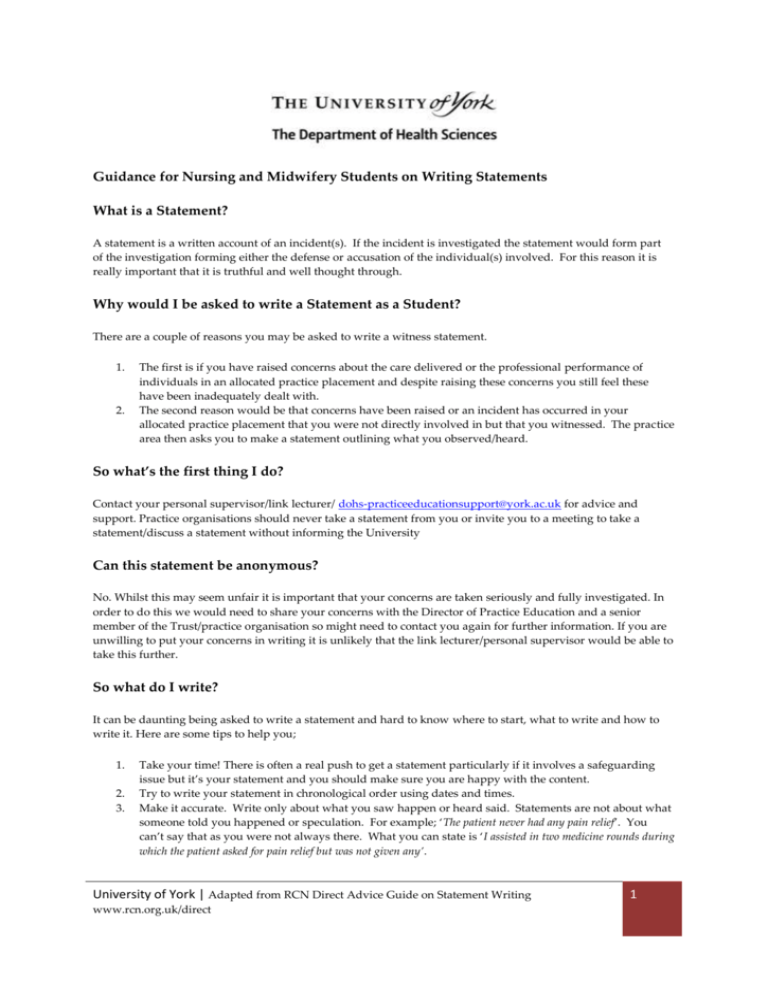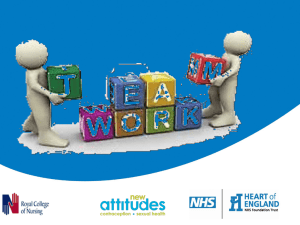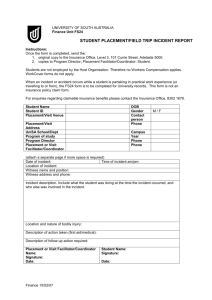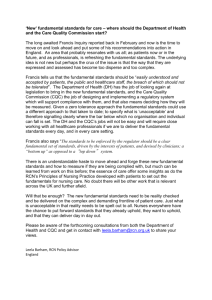Guidance for Nursing and Midwifery students on
advertisement

Guidance for Nursing and Midwifery Students on Writing Statements What is a Statement? A statement is a written account of an incident(s). If the incident is investigated the statement would form part of the investigation forming either the defense or accusation of the individual(s) involved. For this reason it is really important that it is truthful and well thought through. Why would I be asked to write a Statement as a Student? There are a couple of reasons you may be asked to write a witness statement. 1. 2. The first is if you have raised concerns about the care delivered or the professional performance of individuals in an allocated practice placement and despite raising these concerns you still feel these have been inadequately dealt with. The second reason would be that concerns have been raised or an incident has occurred in your allocated practice placement that you were not directly involved in but that you witnessed. The practice area then asks you to make a statement outlining what you observed/heard. So what’s the first thing I do? Contact your personal supervisor/link lecturer/ dohs-practiceeducationsupport@york.ac.uk for advice and support. Practice organisations should never take a statement from you or invite you to a meeting to take a statement/discuss a statement without informing the University Can this statement be anonymous? No. Whilst this may seem unfair it is important that your concerns are taken seriously and fully investigated. In order to do this we would need to share your concerns with the Director of Practice Education and a senior member of the Trust/practice organisation so might need to contact you again for further information. If you are unwilling to put your concerns in writing it is unlikely that the link lecturer/personal supervisor would be able to take this further. So what do I write? It can be daunting being asked to write a statement and hard to know where to start, what to write and how to write it. Here are some tips to help you; 1. 2. 3. Take your time! There is often a real push to get a statement particularly if it involves a safeguarding issue but it’s your statement and you should make sure you are happy with the content. Try to write your statement in chronological order using dates and times. Make it accurate. Write only about what you saw happen or heard said. Statements are not about what someone told you happened or speculation. For example; ‘The patient never had any pain relief’. You can’t say that as you were not always there. What you can state is ‘I assisted in two medicine rounds during which the patient asked for pain relief but was not given any’. University of York | Adapted from RCN Direct Advice Guide on Statement Writing www.rcn.org.uk/direct 1 4. 5. 6. 7. Try to avoid hearsay such as ‘I heard Staff Nurse X saying she had seen Staff Nurse Y take the patient’s pain relief herself’. Try not to use emotionally laden language i.e. ‘the ward was in chaos!’ It can be difficult to fully describe your experience without this type of language but you need to consider what did you see /hear that led you to the judgment that the ward was chaotic? If you can’t remember everything that happened simply state what you can recall. Never make anything up, elaborate or exaggerate. Always keep a copy! You might be asked to discuss the statement further and if you make lots of changes it might affect your credibility. So what should it look like? There are some general presentation tips which can make it easier to read and navigate such as; Make sure your name, contact details and programme, cohort and year of study are on the top of the first page. Number all the pages. Use clear wide margins at each side. All paragraphs must be numbered and should be short, precise and no more than six lines long. Paragraphs should have subject headings, where appropriate. Lines should be double spaced. Write in the first person (i.e., I, me) Have your statement typed. If this is not possible, use plain white A4 paper and write neatly in black ink or ballpoint. It is likely to be photocopied several times. Remember to sign and date the statement You can write your statement any way you like but if you are struggling to begin just think of it structured like a short essay. You can use the following template; Name Programme, Cohort and Year of Study Address Telephone number Subject of statement (e.g. patient/client/staff member X at what incident/location) 1. Introduction I am responding to a request for written statement made by [insert name of individual requesting the statement].This statement is based on [personal recollection/review of records, or combination]. I was on placement in [insert the practice experience placement in which the subject of the statement took place] from [insert allocation dates]. This was my [first/second etc] placement in my programme. 2. Narrative Explain the event, incident or accident in chronological order Use sub headings and new paragraphs to structure your statement, for example: Description of incident(s) (if more than one incident number them incident 1, 2, 3, etc.) Date, time and location of the incident(s)? Who was involved? What was their role? What conduct was observed? What was said? Were there any witnesses to the incident? University of York | Adapted from RCN Direct Advice Guide on Statement Writing www.rcn.org.uk/direct 2 Who were these witnesses? What were their roles? How you initially raised concerns and to whom? What response did you get to your concerns? Document any informal meetings you have had concerning the incident (s) Outline any telephone calls you have had concerning the incident (s) 3. Summary or closing statement Recap the main points, and avoid adding new information or comments. 4. References List all documents referenced in your statement, and, if possible, where to find them, including: • patient records, notes, and departmental documents • local policies or procedures • national standards or evidenced based information • professional codes and guides. 5. Signature Always sign and date your statement Once I’ve written the statement what do I do next? Check it! Check it! And Check it again! Once you have written your statement, check the content for: Accuracy – can the facts be evidenced? Relevance – are the facts and details clearly and objectively explained? Clarity – avoid generalisations and always write the subject of an abbreviation or acronym in full at first mention. Concise – stick to the points raised but don’t sacrifice essential detail for brevity. Always ensure you follow a logical sequence. Clear language – don’t assume that the reader has any knowledge of the subject or environment of care; any intelligent lay person should be able to understand the content. Compliance – follow any professional codes, local policies and confidentiality guidelines. It is always worth getting any statement you prepare checked by your personal supervisor before you submit it. What happens after I have written the statement…where does it go? Different types of statements have different purposes. The one thing they all have in common is that they are used to enable the practice area to collect information and address any concerns. In order for the practice area to investigate they will need to share your statement with others, usually a senior nurse/midwife who will act as the trusts designated ‘investigating officer’. You might be asked to meet with the investigating officer and sometimes the Practice Learning Facilitator (PLF). You should always be accompanied by a member of the university, ideally the Director of Practice Education. This meeting allows not only the Trust to ask you for any clarification they need about your statement in order that they get the ‘full picture’ but also for the Trust to update you on any action taken thus far in relation to the event/incident outlined in the statement. The tone of the meeting will always be supportive as everyone at the meeting, including you, are there to ensure the quality of care we all deliver is of the highest standard. The investigating officer will then informally explore the issues raised by interviewing other members of practice staff involved and/or checking notes/documentation etc. This University of York | Adapted from RCN Direct Advice Guide on Statement Writing www.rcn.org.uk/direct 3 helps determine how serious the event/incident is and whether it potentially involves disciplinary action. However, from a student’s perspective often this meeting is all that is needed and the Trust will form an action plan related to concerns and keep you updated with on-going progress. Could I be called as a witness? The statement you make may be used in a disciplinary or other hearing. If the contents are not challenged the statement will form part of the evidence in the case and you may not be called as a witness. If the contents are disputed or more detail is asked for you may be called as a witness. You will then be questioned on the basis of what is contained in the statement. This is a very formal proceeding and you should always be accompanied by a supporter from the university, ideally the Director of Practice Education. Disciplinary meetings are usually organised by the Trusts Human Resources (HR) department and they should send you a letter to invite you to the meeting. You need to read this letter very carefully alongside the trusts disciplinary policy. If you feel underprepared or are not sure what is happening it is essential that you get in touch with the HR contact as you need to feel fully prepared. The Director of Practice Education or your personal supervisor can help you. So what’s a disciplinary like then? A disciplinary usually involves many senior staff and usually always a trade union representative supporting the person in question. It can be quite daunting which is why it is so very important to have someone there to support you. You also need to be aware that the person/those you have written the statement about will be at the hearing whilst you are being questioned. The important thing to remember is that you are not on trial!! You should answer honestly and truthfully and as stated before add no embellishment. If at any time you feel overwhelmed you can ask for a break or a drink of water. The person supporting will also be watching you for signs of stress and can interject if needed. What happens next? Once you have added your ‘bit’ you are asked to leave and the hearing will continue. After the hearing is complete and a decision is taken the Trust should always let you know the outcome. All information is confidential so you should not share the details with friends or family. However, you will need to debrief after the event and it is important that you seek support from the individual who accompanied you to the hearing very soon after the event as they will be aware of all the information shared during the hearing and this will enable to you to talk freely. Finally Raising and escalating concerns is never easy but the people in our care are vulnerable and they trust us as professionals to do the right thing. If you have read this far then we suspect you have already or are considering speaking up for someone….good for you! Resources RCN Direct www.rcn.org.uk/direct University of York | Adapted from RCN Direct Advice Guide on Statement Writing www.rcn.org.uk/direct 4 NMC (2010) Raising and Escalating Concerns : Guidance for nurses and midwives ww.nmcuk.org/raisingconcerns Director of Practice Education -Fiona.mcinnes@york.ac.uk University of York | Adapted from RCN Direct Advice Guide on Statement Writing www.rcn.org.uk/direct 5







